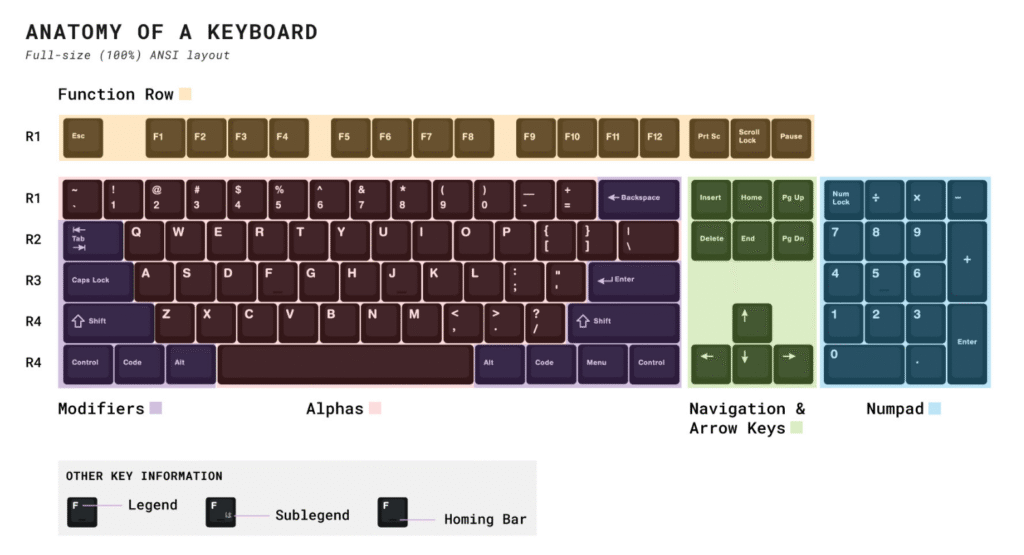How to Choose a Mechanical Keyboard: A Beginner’s Guide to Layouts, Switches, and Features
Mechanical keyboards can feel confusing if you’re new. What’s the difference between a $40 keyboard and a $200 one? What are “switches”? What’s “hot-swap”? This page explains everything you need to know — in simple language — so you can choose the right keyboard for your needs.

What is a Mechanical Keyboard?
A mechanical keyboard uses physical switches under each key.
Unlike a cheap “membrane” keyboard (like what comes with most office PCs), each key on a mechanical keyboard has its own mechanical switch that registers a press with a precise click or bump.
This makes typing feel:
- More responsive
- More accurate
- Longer-lasting (mechanical switches often last 50+ million keypresses)
You can start by using our compare tool!
Filters
Table
Switches (the heart of a mechanical keyboard)
Each key has a “switch” underneath that determines how it feels and sounds.
Types of switches:
- Linear:
- Smooth all the way down
- No bump or click
- Quietest
- Great for gaming
- Example: Cherry MX Red, Gateron Yellow
- Tactile:
- Has a noticeable bump halfway down
- No loud click
- Good for typing
- Helps avoid accidental keypresses
- Example: Cherry MX Brown, Boba U4T
- Clicky:
- Bump + audible “click” sound
- Very loud
- Some people love it for typing
- Others find it too noisy
- Example: Cherry MX Blue, Kailh Box White
🎯 Tip: If you don’t know which one you like, try a switch tester (on Amazon)
Layouts (keyboard sizes)
Mechanical keyboards come in different sizes. You don’t always need a full-sized keyboard.
| Layout | Description | Use Case |
|---|---|---|
| Full-size (100%) | All keys including number pad | Good for office work, spreadsheets |
| Tenkeyless (TKL) | No number pad | Saves space, still familiar |
| 75% | Compact TKL with tight layout | Balance between compact and functional |
| 65% | No function row, no numpad | Very compact, still has arrows |
| 60% | Only main keys, no arrows or function row | Popular for gaming and minimal setups |
| 40% | Only letters + modifiers | Niche, requires learning custom layers |

🎯 Most people start with TKL or 65%. 60% is great if you want something very small.
Hot-Swappable Keyboards
“Hot-swap” means you can pull out switches and replace them without soldering.
- Try different switch types on the same keyboard
- Easy maintenance or upgrades
- Great for beginners who want to experiment
🎯 Most Keychron boards are hot-swappable. Avoid soldered PCBs unless you’re ready to modify with a soldering iron.
Want to compare keyboards?
Top Picks & Popular Models
Each pick is based on real-world performance, community feedback, and hands-on experience, not just specs.
Keycaps
Keycaps are the plastic tops of the keys. They affect feel, sound, and look.
Materials:
- ABS:
- Cheap, smooth
- Can become shiny with use
- PBT:
- More textured
- Longer-lasting
- Usually preferred
Legends (the letters on the keys):
- Laser-etched: basic, wears off over time
- Dye-sub: printed into the plastic, more durable
- Double-shot: two plastics molded together — best quality
Profiles (shapes of the keycaps):
- OEM, Cherry, SA, DSA, MT3… they all feel slightly different.
- OEM / Cherry are standard
- SA / MT3 are taller, retro-style
- DSA is flat
🎯 Most people are fine with OEM or Cherry profile. You can always upgrade later.
Connectivity
- Wired (USB-C):
- Most reliable
- No battery needed
- Bluetooth:
- Wireless
- Some delay if not well-made
- 2.4GHz Wireless (with dongle):
- Often faster and more stable than Bluetooth
- Better for gaming
🎯 If you use multiple devices (e.g., Mac + iPad), Bluetooth is very convenient.
Software and Customization
Many mechanical keyboards are programmable. You can:
- Change what each key does (remap)
- Add macros (e.g., type a phrase with one key)
- Control RGB lighting
- Set up layers (e.g., Fn + key to add extra functions)
Common software:
- QMK / VIA – Open-source, powerful, works on many custom keyboards
- Keychron, Drop, Epomaker – Each has its own software
🎯 Some keyboards need no software – you program them directly using VIA.
Other terms you’ll see
- Stabilizers: help large keys (like Spacebar) feel smooth
- Plate-mounted vs PCB-mounted switches: how switches are held in place
- Gasket mount / tray mount: affects sound and typing feel
- Modding: lubing switches, swapping stabilizers, dampening sound – common in the hobby
Want to compare keyboards?
Top Picks & Popular Models
Each pick is based on real-world performance, community feedback, and hands-on experience, not just specs.
